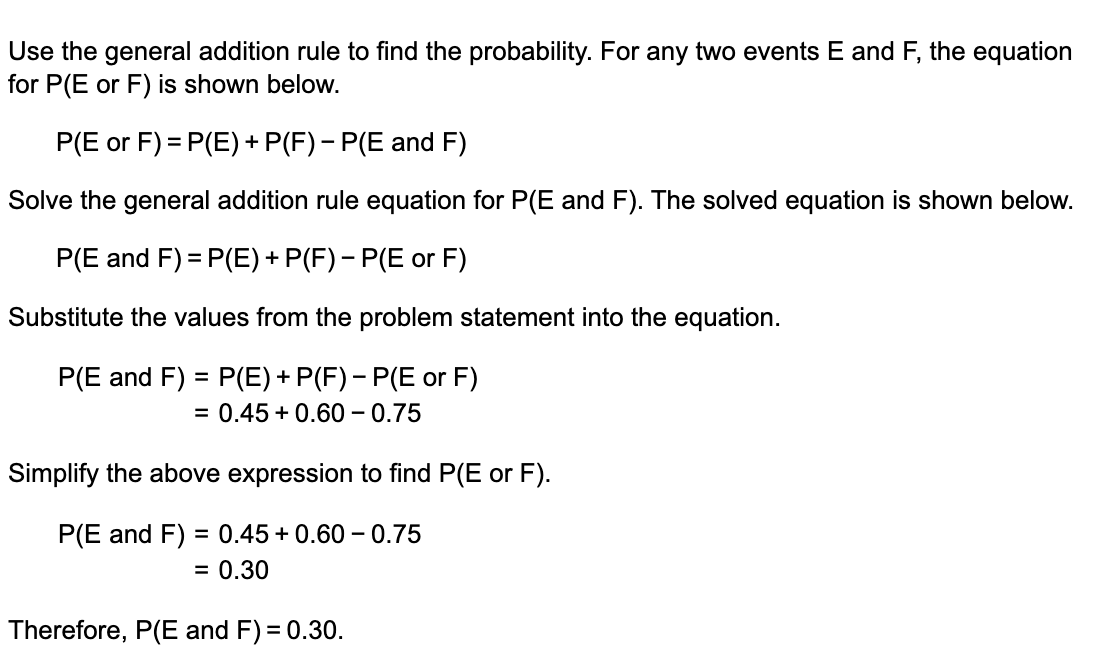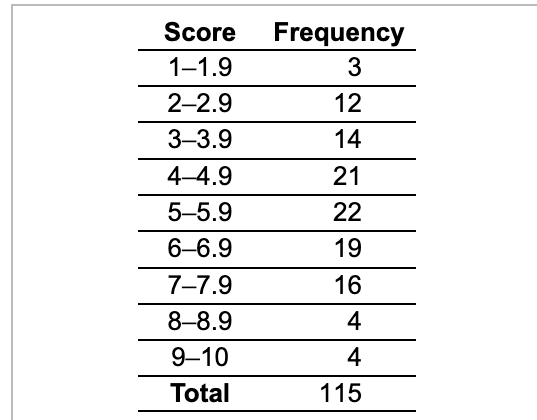5.2 Addition Rule and Complememnts (AND FLASHCARDS WITH HW)
1/8
There's no tags or description
Looks like no tags are added yet.
Name | Mastery | Learn | Test | Matching | Spaced |
|---|
No study sessions yet.
9 Terms
5.) A probability experiment is conducted in which the sample space of the experiment is
S = {11,12,13,14,15,16,17,18,19,20,21,22}, and E ={12,13,14,15,16,17,18}.
Assume each outcome is equally likely.
List the outcomes in Ec. Then, find P( Ec )
Part 1:
The complement of E, denoted is all outcomes in the sample space S that are not outcomes in the event E.
This means there are some outcomes in S that are not in event E. Those events are Ec (outcomes in the sample space not listed in event E)
So, Ec = {11, 19, 20, 21, 22}
Part 2:
To find P( Ec ), divide the number of outcomes in Ec by the number of outcomes in S.
Step 1: Find N( Ec ) **number of Ec
N( Ec ) = 5
Step 2: Find N(S)
N(S) = 12
Step 3: Find P( Ec ) and round to three decimal points.
P( Ec ) = N( Ec ) / N(S)
plug values into the formula —> 5/12
Answer:
P( Ec ) = 0.417
6.) If P(E) = 0.45 and P(F) = 0.60, find P( E and F) if P (E or F) = 0.75

Find the probability P( Ec ) if P(E) = 0.32
Formula: P( Ec ) = 1 - P(E)
1 - 0.32
P( Ec ) = 0.68
If P(E) = 0.40, P(E or F) = 0.45, and P(E and F) = 0.20, find P(F)
Use this equation:
P (E or F) = P(E) + P(F) - P(E and F)
Plug values into equation above ^
0.45 = 0.40 + P(F) - 0.20
Isolate P(F) on one side
0.45 = 0.40 + P(F) - 0.20
0.45 - 0.40 = P(F) - 0.20
0.45 - 0.40 + 0.20 = P(F)
Add/Subtract. That value is P(F)
0.45 - 0.40 + 0.20 = P(F)
0.05 + 0.20 = P(F)
0.25 = P(F)
A golf ball is selected at random from a golf bag. If the golf bag contains 4 balls of type 1, 6 balls of type 2, and 5 balls of type 3. Find the probability of the following event: “The golf ball is of type 1 or type 2”
Match with appropriate equation
“The golf ball is of type 1 or type 2” —> P(E or F) = P(E) + P(F)
Find P(1) and P(2)
P(E) = N(E) / N(S)
P(1) = 4 / 15
= 0.26
P(2) = 6 / 15
= 0.4
Add P(1) and P(2). the sum is the probability of type 1 or 2.
= 0.26 + 0.4
= 0.66
10.) The following probability model shows the distribution of injuries of youth baseball players, ages 5–14, according to researchers at SportMedBc. The Probability Model is down below. Complete parts (a) through (d).
Injury Location | Probability |
Head | 0.111 |
Face | 0.328 |
Wrist | 0.048 |
Hand | 0.157 |
Knee/Ankle | 0.111 |
Other | 0.245 |
(a) Verify that this is a probability model.
(b) What is the probability that a randomly selected baseball injury to a 5-14 year old is to the face or wrist?
(c) Interpret the probability you got from (b).
(d) What is the probability that a randomly selected baseball injury to a 5-14 year old is to the head, face, or wrist?
(e) Interpret the probability you got from (d).
(f) What is the probability that a randomly selected baseball injury to a 5-14 year old is to something other than the face?
(g) Interpret the probability you got from (f).
(a)Yes; the probability of all events in the table is greater than or equal to 0 and less than or equal to 1, and the sum of the probabilities of all outcomes equals 1.
(b) P (E or F) = P(E) + P(F) —> P (Face or Wrist) = P(0.328) + P(0.048) => 0.376
Use the Addition Rule for Disjoint Events to find the probability. The rule states that if E and F are disjoint (or mutually exclusive) events, then P(E or F)=P(E)+P(F)
(c) If 1000 baseball injuries to 5-14 year-olds were randomly selected, one would expect about 376 of them to have happened to the face or wrist.
Review the properties of probabilities and then interpret this probability in the context of the problem. Remember, the more repetitions of an experiment, the closer the proportion with which the event occurs will be to the computed probability, but the observed proportion will not necessarily equal the probability. Also, note that the probability model shows the distribution of injuries by location for youth baseball players aged.
People aren’t decimal points. Thus, you must convert the probability into a whole number in order to describe how many people in its accurate unit of measure.
0.375 —> 375
found by: (0.375 × 100), or you just drop the ‘ 0. ’ and write the number that follows it.
(d) P (E or F) = P(E) + P(F) —> P (Head or Face or Wrist) = P(0.111) + P(0.328) + P(0.048) =>
Use the Addition Rule for Disjoint Events to find the probability. The rule states that if E, F, and Gare disjoint (or mutually exclusive) events, then P(E or F)=P(E)+P(F)+P(G)
(e) If 1000 baseball injuries to 5-14 year-olds were randomly selected, one would expect about 487 of them to have happened to the head, face, or wrist.
(f) Im not gonna write it out lol, but the answer is 0.672
Computed the same way I did in part (d). I added all probabilities the question asks for; that is, each probability in the Model EXCEPT the probability for “Face”
(g) If 1000 baseball injuries to 5-14 year-olds were randomly selected, one would expect about 672 of them to have happened to the head, face, or wrist.
11.) In an effort to reduce the number of hospital-acquired conditions (such as infection resulting from the hospital stay), Medicare officials score hospitals on a 10-point scale with a lower score representing a better patient track record. The federal government reduces Medicare payments to those hospitals with the worst scores. The following data represent the scores received by a set of Illinois hospitals. Complete parts (a) through (d).

(a) Determine the probability that a randomly selected hospital in Illinois has a score between 5 and 5.9.
(b) Determine the probability that a randomly selected hospital in Illinois has a score that is not between 5 and 5.9.
(c) Determine the probability that a randomly selected hospital in Illinois has a score less than 9.
(d) Suppose Medicare reduces Medicare payments to any hospital with a score of 8 or higher. What is the probability a randomly selected hospital in Illinois will experience reduced Medicare payments? Interpret this result. Is it unusual?
(e) Interpret the probability from part (d).
(f) Is the probability from parts (d) and (e) unusual?
(a) 0.191
If S is the sample space of an experiment, then the probability of an event E can be found by using the following formula: P(E) = N(E) / N(S) —>
where N(E) is the number of outcomes in the event and N(S) is the number of outcomes in the sample space.
(b) 0.809
Use the complement rule. P(Ec ) = 1 - P(E)
This is used to find outcomes in a sample spacethat are NOT apart, or asked of, in the event. Using the complement rule for this example would look like 1 - 0.191
(c) 0.965
identify values of P(E) and N(S)
P(E) is P(9 or more)
Find what the frequency for ‘9 or more’ is (that is N(E))
Plug N(E) and N(S) into formula for for P(E)
N(E) is 4 and N(S) is 115 —> 4/115 = 0.035
Next, plug into the complement rule equation:
1 - 0.035
= 0.965
(d) 0.070
P(Events w/ a score of 8 or higher) —> two events, and they both have a frequency of 4.
Add the frequencies together and divide by total.
4+4 is 8 —> 8/115
= 0.070
(e) If 1000 Illinois hospitals were randomly selected, one would expect approximately 70 of them to experience reduced Medicare payments.
(f) No
It is not unusual because the probability of experiencing reduced Medicare payments is greater than 0.05
Addition Rule for probabilities happening at the same time is P (E or F) = P(E) + P(F) - P (E and F).
According to a center for disease control, the probability that a randomly selected person has hearing problems is 0.158. The probability that a randomly selected person has vision problems is 0.094. Can we compute the probability of randomly selecting a person who has hearing problems or vision problems by adding these probabilities? Why or why not?
A. No, because hearing problems and vision problems are events that are too similar to one another.
B. No, because hearing and vision problems are not mutually exclusive. So, some people have both hearing and vision problems. These people would be included twice in the probability.
C.Yes, because hearing and vision are two different senses, and therefore, they are two unique problems.
D. Yes, because this is an application of the Addition Rule for Disjoint Events.
B. No, because hearing and vision problems are not mutually exclusive. So, some people have both hearing and vision problems. These people would be included twice in the probability.
Some people have both hearing and vision problems. This means that the events of having a hearing problem and having a vision problem are not disjoint (or not mutually exclusive). Remember, when two events are not disjoint the General Addition Rule must be used, where the probability is found by adding together the two given probabilities and subtracting the probability of a person having both problems. If the probability of a person having both problems is not subtracted out, then these people will be included twice in the probability.